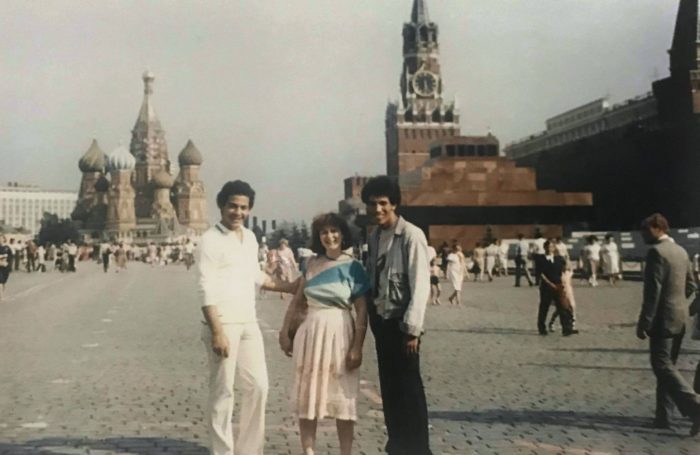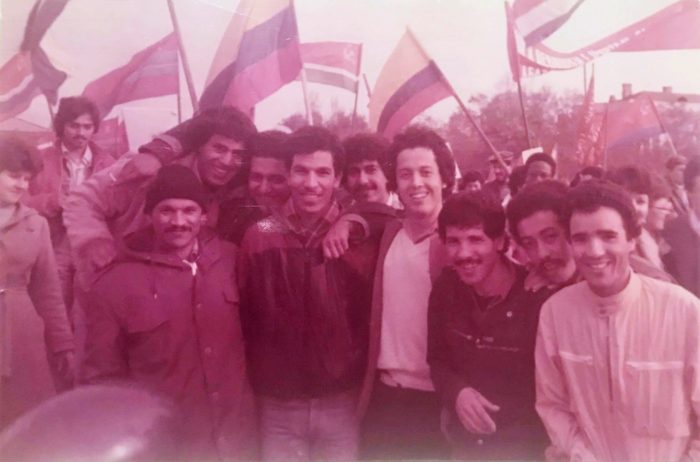“In Russia, my father, Taoufik, would have his mother send him blue jeans and movie tapes from the United States. He sold them to Russians and could make a significant extra income, enough to live well for a few months,” says Aniss. Aniss Jdidi is an energetic young man, with the looks of a foreigner in his native country: people call him Russi, Ruska, or simply the blond, and he himself is a product of this slice of history, unknown to most Moroccans.
Driving on the Casablanca-Rabat highway, sunglasses on, weaving swiftly through traffic, Aniss recounts the story of his father, Taoufik, or “Tao,” who went to study in the USSR in the 1980s. There, he met his future wife, a Ukrainian literature student. Aniss grew up in Rabat, where he always saw his father spending time with his circle of Moroccan friends from Russia. They gathered between the offices of AMLUIS (the Association of Moroccan Graduates of Soviet Universities and Institutes) and the Rabat pétanque club, where they would discuss, if not remake, the world—or at least Morocco—bonded by their Soviet experience. Today, Aniss’s late father, Taoufik Jdidi, is a name that opens doors among Moroccans who share this history.
Especially notable is the story of AMLUIS. The association’s headquarters, established in 1976, has a somewhat old-fashioned and dim atmosphere. A large oval meeting table leans between a sawhorse and a chair; trophies, portraits of former association presidents—often mustachioed—and Soviet diplomas line the shelves of a large bookcase filled with dozens of books in Russian, located in the heart of the Agdal district in Rabat. In a brighter adjoining room, several members have gathered to share their stories.

Soviets, by default
“Kiev, Moscow, Leningrad, Volgograd, Rostov, Belgorod, Kharkov, Odessa, Almaty, Astrakhan…” recites the president of the association, Mohamed Faquiri, tracing a map of the past—a map of Moroccans who moved to the USSR to pursue their university studies. But why did these Moroccans travel so far? Sociologist Grazia Scarfò Ghalleb, along with Kamel Mellakh and Monique de Saint-Martin, explored this in their book, Studying in the East (Karthala, 2015), where they interviewed many former students.
To explain this movement, she notes first that “Morocco, upon gaining independence in 1956, needed to rebuild its human resources, particularly with a strong demand for technical expertise. To achieve this, it encouraged its students to study abroad until it could establish its own institutions. The departure of young Moroccans to the USSR fits within this context.”
The USSR offered scholarships and provided comprehensive support
As for choosing the USSR, it was mainly “an option for Moroccans who couldn’t afford to study in France,” says Abderrahmane Benslimane, a retired engineer who studied in Odessa, Ukraine, after a year at the IUT in Cachan. Scholarships were initially provided by unions for the first group of students in the late 1950s. Later, bilateral agreements between the two governments led to an entire scholarship system supported by the Moroccan-Soviet Friendship Association and Morocco’s Ministry of Cadre Training.
Contrary to popular belief, not all students who went there were committed communists. While some embraced the ideology, the majority were drawn by Soviet scholarships, which allowed them access to rigorous education without incurring debt. Sociologist Grazia Scarfò Ghalleb explains that, for many non-political students, the choice was primarily pragmatic: “Behind these students’ journeys were families willing to go to great lengths to ensure the success of their child’s educational path. They did the best they could within their means, and most engineers trained in the Soviet Union came from relatively modest families. The young people, for their part, were determined to study at all costs—not necessarily in the USSR. Nearly all my interviewees had initially tried to enroll in France, Belgium, Tunisia, or Morocco. When those attempts failed, the USSR, offering scholarships and comprehensive support, became an ideal destination for these young people and their families.” In fact, most students opted for technical fields, which were less ideologically driven than social sciences programs.

“Just like home”
Fatima Laabdi, a civil servant at the Ministry of the Interior, recounts her experience at Kiev University: “When I arrived at Moscow airport in 1989, the first thing I remember was the infrastructure, the buildings, the streets—everything was grandiose. I thought, ‘Ah, this is why they say it’s a big country!’ And on campus, the atmosphere was very family-like. It felt just like home. Everyone mingled with everyone. There were many other foreigners—Africans, Latin Americans, almost 120 nationalities were represented, more than half the globe. I sometimes feel nostalgic for all that. I really loved that country and its people. In fact, I still have friends there.”
Their travel stories are filled with night trains, hot samovars, and vodka shared in the compartments
Attika Rhalib, several years her senior, was one of the first women to study in the USSR, in 1969. With the firm tone of a retired Russian language teacher, she shares her admiration for the Soviet education model: “If I had to do it all over again, I would study in the USSR. The student-teacher relationship there was unforgettable, humane, and caring. Even in a lecture, the professors knew each student’s name. Language was never a barrier because Russian was taught intensively for the first six months, and attendance was mandatory. Professors were available half a day each week solely to give advice and meet with their students.”
The other center of the world
The daily life of students was far from the stereotypical austerity one might expect, according to those who experienced it: “We ate very well in the USSR. The supermarkets might have been empty, but family freezers were full. We Moroccan students made stews, tajines, with spices we brought from home. Then we’d invite everyone over. The cultural life was vibrant too; on campus, we had access to screenings, dance, and theater,” explains Attika Rhalib, still captivated by the cosmopolitan and friendly atmosphere: “I connected with people of all nationalities—Arabs, Mexicans, Asians. I even had two Japanese friends, and we would chat in Russian.”

The association president, Mohamed Faquiri, adds, “There were several clubs on campus. The Egyptian club offered film screenings and tea, while the Iraqi club served Arabic dinners, American cigarettes, and alcoholic drinks.”
Hassan El Mardi, now a seasoned unionist with the air of a wily veteran of institutions, takes on a youthful spark as he recalls his student years in Astrakhan, a seaside town nestled between the turbulent Volga River and the Caspian Sea. Barely twenty, he became a regular at the town’s bazaar, gaining intimate knowledge of the region’s various fish and their preparation methods.
This man who “ate caviar by the spoonful” went to the USSR to study fishing and become a ship captain but eventually changed paths to focus on electromechanics. However, he completed internships as an electromechanical technician aboard fishing vessels that took him from Riga, in the Baltic Sea, to Mauritania’s Atlantic coast.
The common thread among these Moroccans who went east is the extensive travel across the vast country and the epic journeys back to Morocco for summer vacations: tales of speeding night trains, hot samovars, and vodka shared in compartments.
Hassan El Mardi recalls one of these long train journeys through the Iron Curtain to return to Morocco: “At the Polish border, we had to wait for the train cars to be changed because the rails were different from those in Russia. Then we’d transfer at Paris Nord, head to Hendaye, then through Spain, by boat, and finally reach Rabat-Agdal. Back then, no visas were needed, except in Germany.”
Proud of his adventures, president Mohamed Faquiri shares how he completed his internships deep in the taiga or in Kamchatka—the volcanic peninsula in Russia’s far east, accessible only by boat or helicopter.
A difficult return
With their diplomas in hand, Moroccan engineers, pharmacists, and filmmakers returned to their homeland, sometimes accompanied by Russian or Ukrainian wives, as in the case of the Jdidi family.
Drawn by the “richness of the Russian soul,” as they describe it, some alumni of the association initially struggled to find their footing back in Morocco, to the point of feeling “homesick.” Attika Rhalib explains, “Since returning to Morocco, we can’t help but constantly compare it to our experiences in the USSR because it’s ingrained in us. Sometimes, we even feel better over there than here.”
Many have built successful careers, some even reaching prominent positions. Yet, a sense of bitterness lingers for many, rooted in a lack of recognition, starting with their diplomas, in comparison to other, more “classical” elites trained in France’s prestigious schools. “They govern; we work,” remarks Mohamed Faquiri, the association’s president.
Treasurer Hassan El Mardi shares the sentiment: “We received a strong education that Morocco hasn’t fully utilized.” Sociologist Grazia Scarfò Ghalleb echoes this view, noting, “Among all the Soviet-trained engineers I’ve met, Soviet engineering education certainly initiated social mobility. They succeeded as entrepreneurs, experts, and professionals in both the public and private sectors. However, it did not propel them into positions of power.”
Despite the fall of the USSR in 1991, this phenomenon continues
Today, despite the fall of the USSR in 1991, the trend of Moroccan students pursuing studies in the East has not disappeared. On the contrary, their numbers are estimated to have more than doubled, according to sociologist Kamel Mellakh. He estimates that each year, at least 5,000 young Moroccans head to Ukraine for their studies (before the war, editor’s note).
Some are children of the first generation. “After earning his baccalaureate this year, my eldest son chose to move to Kiev for his studies,” says Fatima Laabdi. Just like in the past, but without an institutionalized scholarship system, studying in Ukraine remains an attractive opportunity for quality education at an affordable cost—despite the presence of some unscrupulous intermediaries.
The option is so appealing that, during the World Cup in Russia, two Moroccan fans who had come to watch the Morocco-Spain match in Kaliningrad decided to stay and begin studies there. It seems the rush to the East isn’t over yet.
Written in French by Odilon Gournay, edited in English by Eric Nielson
Archive: Article published in October 2018




